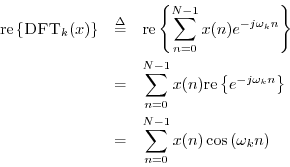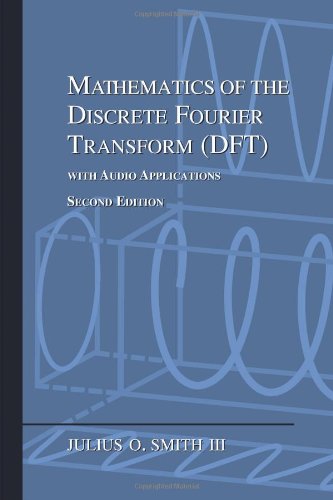Related Transforms
There are alternatives to the Cooley-Tukey FFT which can serve the same or related purposes and which can have advantages in certain situations [10]. Examples include the fast discrete cosine transform (DCT) [5], discrete Hartley transform [21], and number theoretic transform [2].
The DCT, used extensively in image coding, is described in §A.6.1 below. The Hartley transform, optimized for processing real signals, does not appear to have any advantages over a ``pruned real-only FFT'' [74]. The number theoretic transform has special applicability for large-scale, high-precision calculations (§A.6.2 below).
The Discrete Cosine Transform (DCT)
In image coding (such as MPEG and JPEG), and many audio coding
algorithms (MPEG), the discrete cosine transform (DCT) is used
because of its nearly optimal asymptotic theoretical
coding gain.A.9For 1D signals, one of several DCT definitions (the one called
DCT-II)A.10is given by
where
For real signals, the real part of the DFT is a kind of DCT:

Thus, the real part of a double-length FFT is the same as the DCT
except for the half-sample phase shift in the sinusoidal basis
functions
![]() (and a scaling by 2 which is
unimportant).
(and a scaling by 2 which is
unimportant).
In practice, the DCT is normally implemented using the same basic efficiency techniques as in FFT algorithms. In Matlab and Octave (Octave-Forge), the functions dct and dct2 are available for the 1D and 2D cases, respectively.
Exercise: Using Euler's identity, expand the cosine
in the DCT defined by Eq.![]() (A.2) above into a sum of complex
sinusoids, and show that the DCT can be rewritten as the sum of two
phase-modulated DFTs:
(A.2) above into a sum of complex
sinusoids, and show that the DCT can be rewritten as the sum of two
phase-modulated DFTs:
Number Theoretic Transform
The number theoretic transform is based on generalizing the
![]() th primitive root of unity (see §3.12) to a
``quotient ring'' instead of the usual field of complex numbers. Let
th primitive root of unity (see §3.12) to a
``quotient ring'' instead of the usual field of complex numbers. Let
![]() denote a primitive
denote a primitive ![]() th root of unity. We have been using
th root of unity. We have been using
![]() in the field of complex numbers, and it of course
satisfies
in the field of complex numbers, and it of course
satisfies ![]() , making it a root of unity; it also has the
property that
, making it a root of unity; it also has the
property that ![]() visits all of the ``DFT frequency points'' on
the unit circle in the
visits all of the ``DFT frequency points'' on
the unit circle in the ![]() plane, as
plane, as ![]() goes from 0 to
goes from 0 to ![]() .
.
In a number theory transform, ![]() is an integer which
satisfies
is an integer which
satisfies
When the number of elements in the transform is composite, a ``fast number theoretic transform'' may be constructed in the same manner as a fast Fourier transform is constructed from the DFT, or as the prime factor algorithm (or Winograd transform) is constructed for products of small mutually prime factors [43].
Unlike the DFT, the number theoretic transform does not transform to a meaningful ``frequency domain''. However, it has analogous theorems, such as the convolution theorem, enabling it to be used for fast convolutions and correlations like the various FFT algorithms.
An interesting feature of the number theory transform is that all
computations are exact (integer multiplication and addition
modulo a prime integer). There is no round-off error. This feature
has been used to do fast convolutions to multiply extremely large
numbers, such as are needed when computing ![]() to millions of digits
of precision.
to millions of digits
of precision.
Next Section:
FFT Software
Previous Section:
Fast Transforms in Audio DSP








![$\displaystyle 2\sum_{n=0}^{N-1} x(n) \cos\left[\frac{\pi k}{2N}(2n+1)\right],
\quad k=0,1,2,\ldots,N-1$](http://www.dsprelated.com/josimages_new/mdft/img1668.png)
![$\displaystyle 2\sum_{n=0}^{N-1} x(n) \cos\left[\omega_k\left(n+\frac{1}{2}\right)\right]
\protect$](http://www.dsprelated.com/josimages_new/mdft/img1669.png)












